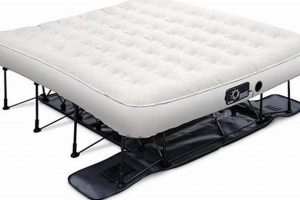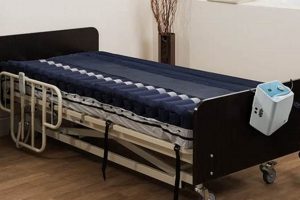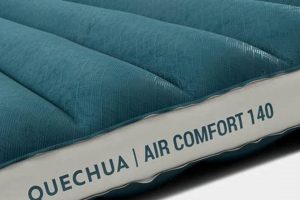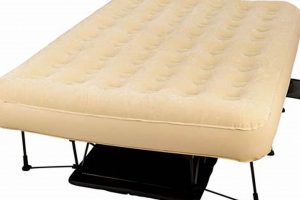Locating the source of air leakage in an inflatable sleeping surface is a necessary task for maintaining its functionality and prolonging its lifespan. The process involves employing various techniques to identify where air is escaping from the mattress’s sealed structure.
Addressing air leaks promptly provides several advantages. It prevents further deflation during use, ensuring a comfortable and supportive sleeping experience. Repairing the leak also conserves resources by avoiding the need for frequent replacements, and minimizes the environmental impact associated with discarding damaged goods. The ability to effectively identify and rectify these issues contributes to the overall utility and longevity of the product.
Several methods exist to pinpoint the area of air escaping from an inflatable mattress. These include auditory detection, tactile inspection, and the application of soapy water to reveal escaping air bubbles. Each technique offers a different approach to effectively locate the source of the problem.
Techniques for Identifying Air Leaks
Effective leak detection involves systematic methods to pinpoint the source of air loss in inflatable mattresses.
Tip 1: Auditory Inspection: Listen carefully near the mattress surface in a quiet environment. A hissing sound indicates air escaping from a puncture or seam separation. Vary the proximity of the ear to different sections of the mattress to isolate the sound.
Tip 2: Tactile Exploration: Gently move a hand across the surface, feeling for air currents. Subtle drafts can pinpoint the location of a small leak imperceptible to the naked eye. Pay particular attention to seams, valves, and areas subjected to stress.
Tip 3: Soapy Water Application: Mix mild dish soap with water in a spray bottle or container. Apply the solution to small sections of the mattress surface. Escaping air will create bubbles, indicating the location of the leak. Avoid oversaturation, which can complicate identification.
Tip 4: Submersion Method (Partial): For smaller mattresses or specific sections, submerge the inflated mattress in water, observing for rising bubbles. This method is particularly effective for locating leaks on the underside of the mattress. Exercise caution to avoid electrical hazards if using an electric pump.
Tip 5: Valve Examination: Inspect the valve for proper closure and seal integrity. A loose or damaged valve can cause slow air loss. Clean the valve and ensure it is properly tightened. Replacement may be necessary if damage is present.
Tip 6: Seam Scrutiny: Closely examine all seams for separation or fraying. Apply slight pressure along the seam to assess its integrity. Air leaks often occur along poorly bonded or stressed seams.
These methods, when applied systematically, facilitate efficient leak detection and enable prompt repair, extending the lifespan of the inflatable mattress.
Following leak detection, appropriate repair methods, such as patching or sealing, should be implemented to restore the mattress’s functionality.
1. Auditory inspection.
Auditory inspection serves as an initial, non-invasive method for detecting air leaks in inflatable mattresses, providing a preliminary indication of potential breaches in the mattress’s airtight seal. Its effectiveness hinges on the ability to discern subtle hissing sounds indicative of escaping air.
- Ambient Noise Mitigation
The success of auditory inspection is directly proportional to the quietness of the surrounding environment. Background noise can mask the faint sound of escaping air, rendering the technique ineffective. Therefore, conducting the inspection in a silent room is essential. This includes minimizing sounds from appliances, conversations, and external sources.
- Proximity and Focus
The proximity of the ear to the mattress surface is a critical factor. Slowly moving one’s ear close to different sections of the mattress, particularly seams and valve areas, enhances the ability to detect subtle hissing sounds. Concentrating on specific areas allows for a more focused assessment and localization of potential leaks.
- Sound Characteristics and Interpretation
The nature of the hissing sound can provide clues about the size and location of the leak. A high-pitched, continuous hiss may indicate a small puncture, while a lower-pitched or intermittent sound might suggest a larger tear or valve issue. Accurate interpretation requires experience and careful attention to the nuances of the sound.
- Limitations and Complementary Techniques
Auditory inspection has limitations, especially in identifying very small leaks or in noisy environments. As such, it often serves as a preliminary step, followed by more precise methods like soapy water application or submersion to confirm and pinpoint the exact location of the air leak.
In conclusion, while auditory inspection provides a valuable initial assessment for identifying potential leaks, its effectiveness is contingent on environmental factors and the inspector’s skill. It is most effective when used in conjunction with other leak detection methods to provide a comprehensive evaluation of the air mattress’s integrity.
2. Soapy water bubbles.
The appearance of soapy water bubbles constitutes a reliable method for identifying air leaks in inflatable mattresses. This technique leverages the surface tension properties of a soap solution to visually indicate the point of air egress, thus facilitating leak detection.
- Mixture Preparation and Application
The solution typically consists of mild dish soap diluted in water. The concentration should be sufficient to generate stable bubbles without excessive suds. The solution is applied to the inflated mattress using a spray bottle or sponge, focusing on areas suspected of leakage, such as seams, valves, and damaged sections.
- Bubble Formation Mechanism
When air escapes from a hole in the mattress, it passes through the soapy water film. The surface tension of the water creates a bubble around the escaping air. The continuous formation of bubbles at a specific location signifies an air leak at that point. The size and frequency of bubbles may indicate the severity of the leak.
- Environmental Considerations and Visibility
The effectiveness of this method depends on environmental conditions. A gentle breeze can disperse the bubbles, hindering accurate identification. Adequate lighting is necessary to clearly observe the bubble formation, especially for small leaks. Minimizing air currents and ensuring sufficient illumination optimize the technique’s efficacy.
p> - Limitations and Refinement
While generally effective, the soapy water method may not detect extremely small leaks that produce negligible bubble formation. Furthermore, excessive solution application can obscure the leak location. Careful observation and judicious solution usage are crucial for accurate leak pinpointing. Alternative leak detection methods, such as auditory inspection, may complement this visual technique.
The strategic application and careful observation of soapy water bubbles provides a clear visual indicator of air leaks in inflatable mattresses. The methods simplicity and accessibility makes it a practical approach for pinpointing leak sources, enabling targeted repairs and prolonging the lifespan of the inflatable mattress.
3. Valve integrity check.
Valve integrity is fundamentally linked to the endeavor to locate air leaks in inflatable mattresses. The valve serves as the primary point of inflation and deflation, and a compromised valve represents a common source of air leakage, frequently misattributed to punctures or material failure elsewhere in the mattress. A deficient valve can manifest as a slow, insidious leak, challenging to detect without direct examination. For instance, a loose valve core, a cracked valve housing, or debris obstructing the valve seat will permit air to escape, resulting in gradual deflation. Thus, excluding the valve as the source of leakage prolongs the diagnostic process and potentially leads to unnecessary repairs.
The practical significance of assessing valve integrity lies in its efficiency. A thorough valve inspection involves visually examining the valve for physical damage, tightening the valve core with an appropriate tool, and applying a soapy water solution to the valve area to identify bubbling, indicative of an air leak. This process is typically faster and less labor-intensive than systematically inspecting the entire mattress surface. Addressing a faulty valve, often through simple tightening or replacement, rectifies the leak immediately. Neglecting this step risks missing the actual leak source, resulting in repeated inflation and eventual frustration.
In summary, incorporating a valve integrity check into the leak detection process significantly enhances the probability of swiftly identifying the source of air leakage in inflatable mattresses. This approach minimizes unnecessary effort, focuses diagnostic efforts on a common failure point, and facilitates prompt and effective repair, ultimately extending the useful life of the product. The process should be considered a front-line tactic when engaging with “how to find a hole in a air mattress.”
4. Seam visual assessment.
Seam visual assessment is a crucial component of effectively locating air leaks in inflatable mattresses. The seams, being the points where different sections of the mattress material are joined, represent inherent weak points in the structure. Stress from inflation, deflation, and user weight concentrates along these seams, predisposing them to separation, tearing, or the development of minute pinholes. Therefore, a thorough visual examination of the seams is a primary step in identifying the cause of deflation in these mattresses.
The process involves carefully inspecting the seams for any signs of damage. This includes looking for visible gaps, frayed edges, or areas where the adhesive or welding has failed. Real-world examples illustrate the significance of this step. An air mattress used frequently for camping may develop seam separations due to constant folding and unfolding, exposing the internal air chamber. Similarly, an air mattress stored in a hot environment could experience adhesive degradation along the seams, leading to slow air leaks. The practical significance of seam visual assessment lies in its ability to detect these issues early, before they escalate into larger, more difficult-to-repair problems. It also avoids misdiagnosing the problem as a puncture in the main body of the mattress, saving time and effort.
In conclusion, seam visual assessment is an indispensable element of the process designed to identify air leaks in inflatable mattresses. This proactive approach facilitates the identification of structural weaknesses, enabling timely repairs and significantly extending the mattress’s lifespan. Recognizing the seams as potential vulnerability points is essential for accurate leak detection and cost-effective maintenance.
5. Tactile air flow.
Tactile air flow serves as a direct, hands-on method for detecting air leaks in inflatable mattresses. This technique relies on the sensitivity of human touch to identify subtle currents of escaping air, providing an immediate indication of potential breaches in the mattress’s airtight seal.
- Sensitivity Calibration
The effectiveness of tactile detection hinges on the individual’s sensitivity to air currents. This necessitates minimizing external disturbances, such as breezes or ventilation, that could mask subtle air flows. Practitioners may need to acclimatize their senses to detect minimal air movement accurately. The angle and proximity of the hand to the mattress surface also influence detection sensitivity.
- Systematic Surface Coverage
Accurate leak detection requires a systematic approach to covering the entire mattress surface. This involves methodically moving the hand across the mattress, paying particular attention to seams, valves, and areas prone to wear and tear. Overlapping strokes ensure complete coverage and reduce the likelihood of overlooking small leaks. Any perceived air movement warrants closer inspection using alternative methods, such as soapy water.
- Environmental Considerations
Environmental factors significantly impact the effectiveness of tactile detection. High humidity can increase skin sensitivity, enhancing the ability to detect air currents. Conversely, dry conditions may reduce sensitivity. Ambient temperature also plays a role; warmer air escaping from the mattress may be easier to detect against a cooler background. Awareness of these factors allows for adjustments to optimize detection.
- Integration with Other Techniques
While tactile air flow provides a direct indication of air leakage, it is most effective when used in conjunction with other leak detection methods. Soapy water application can confirm the presence of a leak and pinpoint its precise location. Auditory inspection may reveal larger leaks that are easily detectable by sound. Integrating multiple techniques ensures comprehensive leak detection and accurate diagnosis.
The ability to discern subtle air currents through tactile inspection forms a crucial element of a comprehensive approach to “how to find a hole in a air mattress.” This technique, when coupled with other diagnostic methods, enables the efficient identification and repair of leaks, extending the lifespan of the inflatable mattress.
6. Submersion test.
The submersion test represents a direct application of physical principles to achieve the objective of finding the source of air leakage. It involves immersing the inflated mattress, or a section thereof, in water, observing for escaping air bubbles that pinpoint the location of the breach. The presence and continuous emanation of bubbles visually confirms the leak’s existence and precise location. This process exploits the density difference between air and water to create a readily observable phenomenon at the leak point.
The importance of submersion is underscored by its ability to detect leaks that other methods may miss. Small punctures or perforations, particularly on the underside of the mattress, are often difficult to locate through auditory or tactile methods alone. Real-world scenarios illustrate this advantage: imagine an air mattress used in a basement prone to dampness; the underside may develop imperceptible mold-induced pinholes. Similarly, wear from contact with rough flooring can create micro-abrasions invisible to the naked eye but detectable through bubble formation during submersion. The test’s practical significance lies in its accuracy and efficiency in isolating these difficult-to-find sources.
In summary, the submersion test provides a valuable and often essential step in the comprehensive process of detecting air leaks. It leverages the physical properties of air and water to create a clear visual indicator of even the smallest leaks. While considerations regarding mattress size and electrical safety must be observed, the submersion test often provides the conclusive evidence needed to target repairs effectively, contributing significantly to the extended lifespan and utility of the inflatable mattress. The submersion test is of great value when considering “how to find a hole in a air mattress.”
Frequently Asked Questions About Air Mattress Leak Detection
This section addresses common inquiries regarding the procedures and best practices associated with locating air leaks in inflatable mattresses.
Question 1: What is the initial step in identifying the source of air loss from an inflatable mattress?
The initial step involves a thorough visual inspection of the mattress surface, seams, and valve. This assessment aims to identify obvious punctures, tears, or valve malfunctions contributing to the deflation.
Question 2: Why is soapy water recommended for leak detection, and how should it be applied?
A solution of mild soap and water reduces surface tension, allowing air escaping from small punctures to form visible bubbles. The solution should be applied lightly to sections of the inflated mattress, observing for bubble formation that indicates leak locations.
Question 3: How does ambient noise affect the effectiveness of auditory leak detection?
Elevated ambient noise levels can mask the subtle hissing sound of escaping air, rendering auditory detection less effective. Leak detection efforts should be conducted in a quiet environment to minimize interference.
Question 4: What are the limitations of the submersion method for leak detection?
The submersion method may be impractical for large mattresses due to size and handling constraints. Additionally, care must be taken to prevent electrical hazards if an electric pump is used during inflation prior to submersion.
Question 5: How frequently should air mattress valves be inspected for leaks?
Valves should be inspected periodically, especially if the mattress exhibits slow deflation. The valve mechanism can loosen or degrade over time, necessitating inspection and potential tightening or replacement.
Question 6: What type of repair is appropriate once a leak is located?
The appropriate repair method depends on the size and nature of the leak. Small punctures can often be patched using adhesive repair kits. Larger tears or seam separations may require more extensive repair or professional attention.
Effective leak detection requires a systematic approach, combining visual inspection, auditory techniques, and the application of soapy water. Identifying and addressing leaks promptly extends the lifespan and usability of inflatable mattresses.
The subsequent section will outline the procedures for effectively repairing identified air leaks.
Concluding Remarks
The preceding sections have comprehensively explored various methods for pinpointing air leaks in inflatable mattresses. Techniques ranging from auditory assessment and soapy water application to valve inspections, seam examinations, tactile analysis, and submersion tests have been delineated. Each method offers unique advantages in detecting leaks of varying sizes and locations, necessitating a combined approach for optimal results. The ability to systematically employ these techniques is crucial for maintaining the integrity and functionality of inflatable mattresses.
Effective leak detection and subsequent repair are integral to prolonging the lifespan of inflatable mattresses, minimizing waste, and ensuring continued user comfort. A proactive approach, incorporating the described techniques, empowers individuals to address leaks promptly, preventing further damage and maximizing the utility of these products. Continued refinement and application of these methods contribute to a more sustainable and efficient use of inflatable mattress resources.







